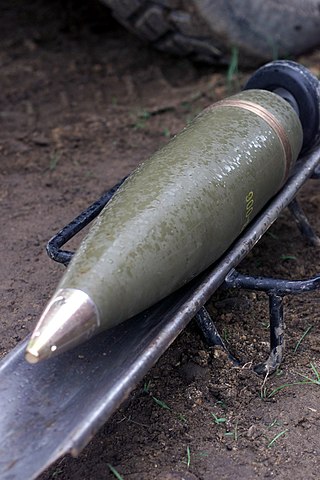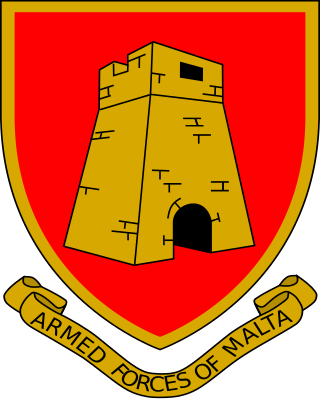Related Research Articles

RDX (abbreviation of "Research Department eXplosive") or hexogen, among other names, is an organic compound with the formula (CH2N2O2)3. It is white, odorless and tasteless, widely used as an explosive. Chemically, it is classified as a nitroamine alongside HMX, which is a more energetic explosive than TNT. It was used widely in World War II and remains common in military applications.

A land mine, or landmine, is an explosive weapon concealed under or camouflaged on the ground, and designed to destroy or disable enemy targets, ranging from combatants to vehicles and tanks, as they pass over or near it.

A shaped charge is an explosive charge shaped to focus the effect of the explosive's energy. Different types of shaped charges are used for various purposes such as cutting and forming metal, initiating nuclear weapons, penetrating armor, or perforating wells in the oil and gas industry.

The M198 is a medium-sized, towed 155 mm artillery piece, developed for service with the United States Army and Marine Corps. It was commissioned to be a replacement for the World War II-era M114 155 mm howitzer. It was designed and prototyped at the Rock Island Arsenal in 1969 with firing tests beginning in 1970 and went into full production there in 1978. It entered service in 1979 and since then 1,600 units have been produced.

C-4 or Composition C-4 is a common variety of the plastic explosive family known as Composition C, which uses RDX as its explosive agent. C-4 is composed of explosives, plastic binder, plasticizer to make it malleable, and usually a marker or odorizing taggant chemical. C-4 has a texture similar to modelling clay and can be molded into any desired shape. C-4 is relatively insensitive and can be detonated only by the shock wave from a detonator or blasting cap.

Bomb disposal is an explosives engineering profession using the process by which hazardous explosive devices are disabled or otherwise rendered safe. Bomb disposal is an all-encompassing term to describe the separate, but interrelated functions in the military fields of explosive ordnance disposal (EOD) and improvised explosive device disposal (IEDD), and the public safety roles of public safety bomb disposal (PSBD) and the bomb squad.

The M107 is a 155 mm high explosive projectile used by many countries. It is a bursting round with fragmentation and blast effects. It used to be the standard 155 mm high explosive projectile for howitzers of the US Army and US Marine Corps, but is being superseded in the US military by the M795.

The Royal Arsenal, Woolwich is an establishment on the south bank of the River Thames in Woolwich in south-east London, England, that was used for the manufacture of armaments and ammunition, proofing, and explosives research for the British armed forces. It was originally known as the Woolwich Warren, having begun on land previously used as a domestic warren in the grounds of a mid-16th century Tudor house, Tower Place. Much of the initial history of the site is linked with that of the Office of Ordnance, which purchased the Warren in the late 17th century in order to expand an earlier base at Gun Wharf in Woolwich Dockyard.

The Mk 153 Shoulder-Launched Multipurpose Assault Weapon (SMAW) is a smoothbore shoulder-fired rocket launcher. It is a portable assault weapon and has a secondary anti-armor ability. Developed from the B-300, it was introduced to United States Armed Forces in 1984. It has a maximum effective range of 500 metres (550 yd) against a tank-sized target.

The M203 is a single-shot 40 mm under-barrel grenade launcher designed to attach to a rifle. It uses the same rounds as the older stand-alone M79 break-action grenade launcher, which utilizes the high-low propulsion system to keep recoil forces low. While compatible with many weapons, the M203 was originally designed and produced by the United States military for the M16 rifle and its carbine variant, the M4. The launcher can also be mounted onto a C7, a Canadian version of the M16 rifle; this requires the prior removal of the bottom handguard.

The 2S5 Giatsint-S is a Soviet/Russian 152 mm self-propelled gun. "2S5" is its GRAU designation. It has nuclear, biological, and chemical protection. The 2S5 is capable of engaging targets at longer ranges and at a higher rate of fire than the more widely produced 2S3 Akatsiya 152 mm self-propelled gun, and is capable of firing nuclear projectiles.
Insensitive munitions are munitions that are designed to withstand stimuli representative of severe but credible accidents. The current range of stimuli are shock, heat and adjacent detonating munitions. A munition can have its vulnerability reduced by a number of means used on their own or in combination such as a reduced vulnerability energetic material, design features, additions or changes to packaging etc. The munition must still retain its terminal effect and performance within acceptable parameters.

The Armed Forces of Malta is the name given to the combined armed services of Malta. The AFM is a brigade sized organisation consisting of a headquarters and three separate battalions, with minimal air and naval forces. Since Malta is the guardian of the European Union's southernmost border, the AFM has an active role in border control.

Fort Walker, formerly Fort A.P. Hill, is a training and maneuver center belonging to the United States Army located near the town of Bowling Green, Virginia. The center focuses on arms training and is used by all branches of the U.S. Armed Forces, independent of any post.

The Type 99 88 mm AA gun was an anti-aircraft gun used by the Imperial Japanese Army during World War II. The Type 99's number was designated for the year the gun was accepted, 2599 in the Japanese imperial year calendar.

Explosives safety originated as a formal program in the United States in the aftermath of World War I when several ammunition storage areas were destroyed in a series of mishaps. The most serious occurred at Picatinny Arsenal Ammunition Storage Depot, New Jersey, in July, 1926 when an electrical storm led to fires that caused explosions and widespread destruction. The severe property damage and 19 fatalities led Congress to empower a board of Army and Naval officers to investigate the Picatinny Arsenal disaster and determine if similar conditions existed at other ammunition depots. The board reported in its findings that this mishap could recur, prompting Congress to establish a permanent board of colonels to develop explosives safety standards and ensure compliance beginning in 1928. This organization evolved into the Department of Defense Explosives Safety Board (DDESB) and is chartered in Title 10 of the US Code. The DDESB authors Defense Explosives Safety Regulation (DESR) 6055.9 which establishes the explosives safety standards for the Department of Defense. The DDESB also evaluates scientific data which may adjust those standards, reviews and approves all explosives site plans for new construction, and conducts worldwide visits to locations containing US title munitions. The cardinal principle of explosives safety is expose the minimum number of people for the minimum time to the minimum amount of explosives.

Military organization (AE) or military organisation (BE) is the structuring of the armed forces of a state so as to offer such military capability as a national defense policy may require. Formal military organization tends to use hierarchical forms.

The Type 94 37 mm quick-firing gun was an anti-tank gun developed by the Imperial Japanese Army. It was used in combat during the Second Sino-Japanese War and World War II. The Type 94's number was designated for the year the gun was accepted, 2594 in the Japanese imperial year calendar, or 1934 in the Gregorian calendar.

The Lithuanian Land Forces (LLF) form the backbone of the Lithuanian Armed Forces, capable of acting as an integral part of NATO forces. Lithuanian Land Forces consist of three brigades, the Engineer Battalion, and the National Defence Volunteers Division.

The United States Army Engineer School (USAES) is located at Fort Leonard Wood, Missouri. It was founded as a School of Engineering by General Headquarters Orders, Valley Forge on 9 June 1778. The U.S. Army Engineer School provides training that develops a wide variety of engineering skills including: combat engineer, bridging, construction, geospatial, topography, diving, and firefighting.
References
- ↑ Military Explosives. Headquarters, Department of the Army. 1989. pp. 8–112.
- ↑ "Ednatol".[ dead link ]
- ↑ Military Explosives. Headquarters, Department of the Army. 1989. pp. 2–17.